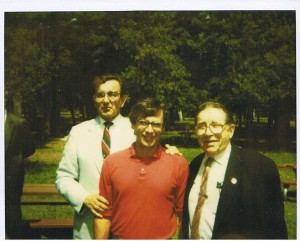
Gov. Rudy Perpich, the author, and Rep. Willard Munger at the dedication of the Munger Trail
The first time I read John Myers’ recent article about the restoration of the St. Louis River (“St. Louis River touted as a better place to be”, DNT 07/05/2014), I was a bit miffed at John. Why? Well, throughout all of the discussion and information contained in the article, there was nary a word as to how the St. Louis River was restored from an open sewer and industrial waste sluice to a productive fishery and recreational draw. I faulted John, one of the last DNT veterans who covered the career of State Representative Willard Munger (yes, he’s related: he’s my uncle), for not calling attention to the history behind the river’s resurgence. But then, after a second read, I realized that John was highlighting what was taking place across the bay, in Superior, Wisconsin, as opposed to in my hometown of Duluth. Still, for today’s readers and young folks to understand the success story of the river, there needs to be some perspective.
My uncle came to Duluth in 1935. Not too long after settling into West Duluth, Willard (who’d grown up fishing the pristine lakes and rivers of Otter Tail County in northwestern Minnesota) discovered the ugly truth about the St. Louis River flowing murkily right out his back door: the St. Louis was an environmental disaster. Human feces from the various municipalities along the river’s banks, coupled with six or seven decades of industrial degradation, had left the waterway an infectious, nauseous, open sewer; a place no child dared swim in and a place from which no adult dared keep a fish. The sturgeons were gone. The walleye were putrid. And muskies? They didn’t exist. Being a life-long political activist, Willard began working with the United Northern Sportsman in the 1940s on two issues: keeping Reserve Mining from gaining a permit to dump taconite waste in Lake Superior and cleaning up the St. Louis River. He and his conservation colleagues (mostly men who loved to hunt and fish) failed in their first task. The second goal, the river’s return to health, took nearly fifty years of hard, dedicated, devoted work to achieve.
Willard ran for elected office in 1952. His primary campaign promise was to stop the pollution of the river. He lost. In 1954, he ran again but his environmental fervor was concealed behind other issues in recognition that folks wanted to hear about economic issues rather than the cleaning up of an estuary. But after he won a seat in the Minnesota House and took office in 1955, Willard immediately set in motion legislative policies that ultimately created the Western Lake Superior Sanitary District (the WLSSD) which, when it came on line in 1974 to treat municipal and industrial waste, immediately began to make a difference in the health of the river. Think of the patience that effort required! Willard started his legislative push to build the WLSSD in 1955 but it took nearly twenty years for his idea, the use of regional sewage treatment centers situated along the major rivers of the state, to come to fruition. Rep. Munger would be quick, if he was still here (he passed away on July 11, 1999) to point out that he had plenty of help from folks along the way, that the clean-up of the St. Louis River was not the work of one man but a process involving sportsmen and women, service groups, labor unions, conservation and environmental organizations, and civic and industrial leaders. Over the fifty years Willard Munger worked to better the water quality of the St. Louis River, he forged a coalition of folks who today might not even be able to break bread due to their political differences. But he was a stubborn man, a man with a dedicated heart, to whom the work was more important than anything else, including the ideology of those he enlisted in his cause.
Today, on both the Minnesota and Wisconsin sides of the great river that is the birthplace of the Great Lakes, people can swim and fish and canoe and boat on a river that, while not perfect, is one hell of a lot cleaner and more useable than it was when Willard Munger wandered into town. A labor leader once called Rep. Munger “an extraordinary, ordinary Minnesotan.” Indeed. Maybe some young person reading this short essay about how the St. Louis River came to be restored to a place of renewed beauty (and the focus of Duluth Mayor Don Ness’s recent promotional efforts) will be inspired to become a public servant with the heart and stubborn resolve of Willard Munger.
One can only hope.
Mark
Mark is a life-long Duluthian, a District Court Judge, and the author of Mr. Environment: The Willard Munger Story, available in bookstores, online, and above under “Books”. An edited version of this essay first appeared in the Duluth News Tribune.



So hard to believe that Willard has been gone for 15 years now. If only we had more like him in public office today. Maybe Don Ness will seek legislative office sometime soon.
Thanks for the always nice memories, Mark, and well done!
Cheers,
John
John:
You were a big part in all he accomplished.
Mark